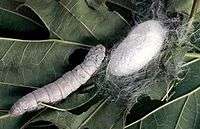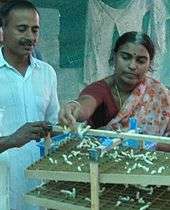Sericulture
Sericulture, or silk farming, is the cultivation of silkworms to produce silk. Although there are several commercial species of silkworms, Bombyx mori (the caterpillar of the domestic silkmoth) is the most widely used and intensively studied silkworm. Silk was believed to have first been produced in China as early as the Neolithic Period. Sericulture has become an important cottage industry in countries such as Brazil, China, France, India, Italy, Japan, Korea, and Russia. Today, China and India are the two main producers, with more than 60% of the world's annual production.

History
According to Confucian text, the discovery of silk production dates to about 2700 BC, although archaeological records point to silk cultivation as early as the Yangshao period (5000–3000 BC).[1] In 1977, a piece of ceramic created 5400–5500 years ago and designed to look like a silkworm was discovered in Nancun, Hebei, providing the earliest known evidence of sericulture.[2] Also, by careful analysis of archaeological silk fibre found on Indus Civilization sites dating back to 2450–2000 BC, it is believed that silk was being used over a wide region of South Asia.[3][4] By about the first half of the 1st century AD, it had reached ancient Khotan,[5] by a series of interactions along the Silk Road. By AD 140, the practice had been established in India.[6] In the 6th century AD, the smuggling of silkworm eggs into the Byzantine Empire led to its establishment in the Mediterranean, remaining a monopoly in the Byzantine Empire for centuries (Byzantine silk). In 1147, during the Second Crusade, Roger II of Sicily (1095–1154) attacked Corinth and Thebes, two important centres of Byzantine silk production, capturing the weavers and their equipment and establishing his own silkworks in Palermo and Calabria,[7] eventually spreading the industry to Western Europe.
- Chinese sericulture process
.jpg) The silkworms and mulberry leaves are placed on trays.
The silkworms and mulberry leaves are placed on trays..jpg) Twig frames for the silkworms are prepared.
Twig frames for the silkworms are prepared..jpg) The cocoons are weighed.
The cocoons are weighed..jpg) The cocoons are soaked and the silk is wound on spools.
The cocoons are soaked and the silk is wound on spools..jpg) The silk is woven using a loom.
The silk is woven using a loom.
Production
The silkworms are fed with mulberry leaves, and after the fourth moult, they climb a twig placed near them and spin their silken cocoons. The silk is a continuous filament comprising fibroin protein, secreted from two salivary glands in the head of each worm, and a gum called sericin, which cements the filaments. The sericin is removed by placing the cocoons in hot water, which frees the silk filaments and readies them for reeling. This is known as the degumming process.[8] The immersion in hot water also kills the silkmoth pupa.
Single filaments are combined to form thread, which is drawn under tension through several guides and wound onto reels. The threads may be plied to form yarn. After drying, the raw silk is packed according to quality.
Stages of production
The stages of production are as follows:
- The female silkmoth lays 300 to 500 eggs.
- The silkmoth eggs hatch to form larvae or caterpillars, known as silkworms.
- The larvae feed on mulberry leaves.
- Having grown and moulted several times, the silkworm extrudes a silk fibre and forms a net to hold itself.
- It swings itself from side to side in a figure '8', distributing the saliva that will form silk.
- The silk solidifies when it contacts the air.
- The silkworm spins approximately one mile of filament and completely encloses itself in a cocoon in about two or three days. The amount of usable quality silk in each cocoon is small. As a result, about 2,500 silkworms are required to produce a pound of raw silk.[9]
- The intact cocoons are boiled, killing the silkworm pupa.
- The silk is obtained by brushing the undamaged cocoon to find the outside end of the filament.
- The silk filaments are then wound on a reel. One cocoon contains approximately 1,000 yards of silk filament. The silk at this stage is known as raw silk. One thread comprises up to 48 individual silk filaments.
Mahatma Gandhi was critical of silk production based on the Ahimsa philosophy "not to hurt any living thing". He also promoted "Ahimsa silk", made without boiling the pupa to procure the silk and wild silk made from the cocoons of wild and semiwild silkmoths.[10][11] The Human League also criticised sericulture in their early single "Being Boiled". In the early 21st century, the organisation PETA has also campaigned against silk.[12]
 The third stage of the silkworm
The third stage of the silkworm Silkworms on a modern rotary mountage
Silkworms on a modern rotary mountage Silk cocoons on mountages
Silk cocoons on mountages
References
- Barber, E. J. W. (1992). Prehistoric textiles: the development of cloth in the Neolithic and Bronze Ages with special reference to the Aegean (reprint, illustrated ed.). Princeton University Press. p. 31. ISBN 978-0-691-00224-8. Retrieved 6 November 2010.
- "2015-10-29240509.html".
1977年在石家庄长安区南村镇南杨庄出土的5400-5500年前的陶质蚕蛹,是仿照家蚕蛹烧制的陶器,这是目前发现的人类饲养家蚕的最古老的文物证据。
- Good, I. L., et al. "New Evidence for Early Silk in the Indus Civilization." Archaeometry, vol. 51, no. 3, June 2009, pp. 457–466. EBSCOhost, doi:10.1111/j.1475-4754.2008.00454.x.
- Vainker, Shelagh (2004). Chinese Silk: A Cultural History. Rutgers University Press. p. 20. ISBN 0813534461.
- Hill, John E. 2003. "Annotated Translation of the Chapter on the Western Regions according to the Hou Hanshu." 2nd Draft Edition. Appendix A.
- "History of Sericulture" (PDF). Governmentof Andhra Pradesh (India) – Department of Sericulture. Archived from the original (PDF) on 21 July 2011. Retrieved 7 November 2010.
- Muthesius, "Silk in the Medieval World", p. 331.
- Bezzina, Neville. "Silk Production Process". Sense of Nature Research. Archived from the original on 29 June 2012.
- "Silk Making: How to Make Silk". TexereSilk.com. Retrieved 25 May 2014.
- Radhakrishnan, S., ed. (1968). Mahatma Gandhi: 100 years. New Delhi: Gandhi Peace Foundation. p. 349. Retrieved 19 April 2013.
- Parekh, Dhimant (11 September 2008). "Ahimsa Silk: Silk Saree without killing a single silkworm". The Better India. Vikara Services Pvt Ltd. Retrieved 19 April 2013.
- "Down and Silk: Birds and Insects Exploited for Fabric". PETA. Retrieved 6 January 2007.
External links
| Wikimedia Commons has media related to Sericulture. |
| Look up sericulture in Wiktionary, the free dictionary. |
_by_Emperor_Huizong.jpg)